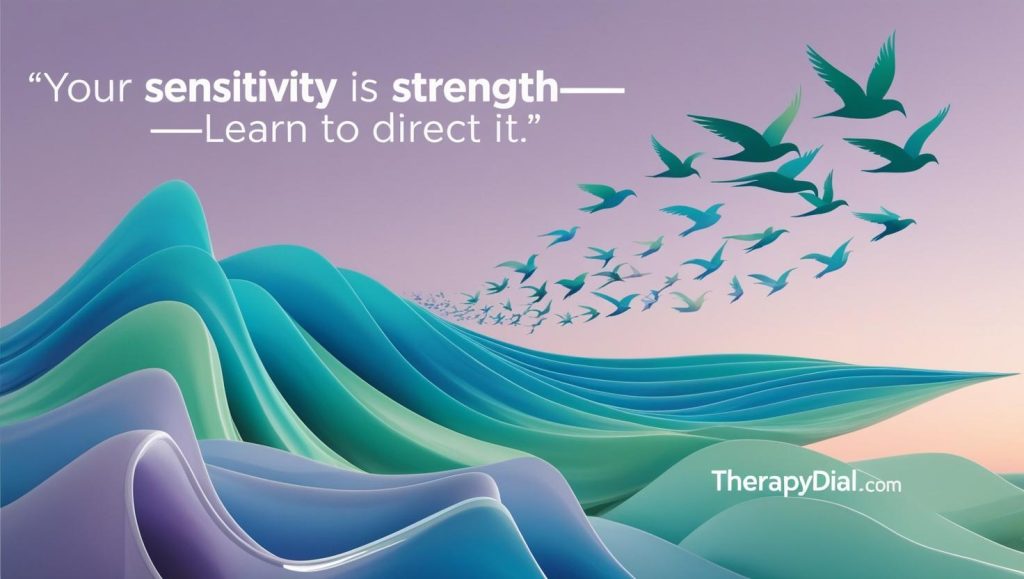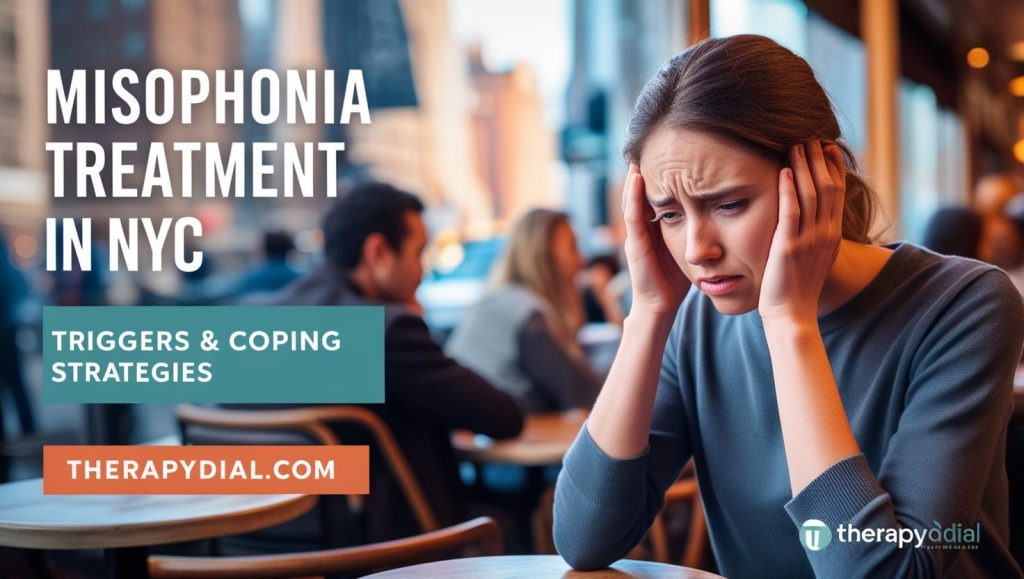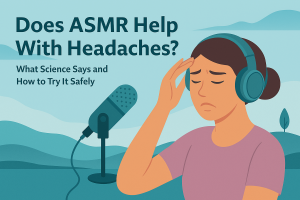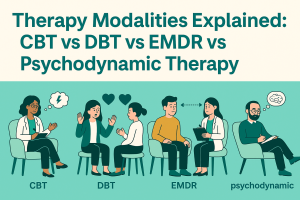If the sound of chewing, clicking pens, or repetitive tapping makes you want to scream—or run—you might be dealing with misophonia. This condition isn’t “just being sensitive.” It’s a real and often debilitating disorder that can disrupt relationships, work, and daily peace.
And if you live in a place like New York City, where triggers can pop up around every corner, managing misophonia can feel especially overwhelming.
But you’re not alone. More New Yorkers are seeking professional help, building practical coping strategies, and finding real relief.
Whether you’re newly diagnosed or searching for support, this guide walks you through triggers, coping tools, and the best treatment options available in NYC.
What is Misophonia?
A Brief Overview of the Condition
Misophonia—literally “hatred of sound”—is a neurological condition in which certain sounds trigger intense emotional and physical responses. It typically starts in childhood or adolescence and can worsen over time if not addressed.
Misophonia isn’t officially classified as a mental disorder in the DSM, but research shows it’s real and life-impacting.
People with misophonia may react to everyday sounds like:
- Eating and chewing
- Lip smacking
- Sniffling or breathing
- Repetitive pen clicking or typing
These aren’t just annoying—they’re unbearable. Reactions range from irritation to explosive anger, panic, or an urgent need to escape the environment.
How It Affects Daily Life
Imagine trying to focus at work while a coworker slurps coffee. Or sitting in a quiet subway car while someone beside you taps their foot nonstop.
For those with misophonia, these scenarios aren’t just uncomfortable—they’re mentally and physically distressing.
Many avoid restaurants, open-plan offices, or public transport altogether. Others wear noise-canceling headphones constantly just to function. Over time, untreated misophonia can lead to social isolation, anxiety, and even depression.
Common Myths About Misophonia
Let’s bust a few common myths:
- Myth: It’s just being picky or irritable.
Reality: Misophonia is a legitimate sensory processing issue with neurological roots. - Myth: It’s the same as general noise sensitivity.
Reality: Misophonia is more specific. It’s not about loudness—it’s about certain repetitive sounds. - Myth: Nothing can help it.
Reality: While there’s no cure, there are effective treatments and coping methods that make a huge difference.
Identifying Common Misophonia Triggers

Sound-Based Triggers
These are the hallmark of misophonia. The most common ones include:
- Mouth sounds: chewing, slurping, swallowing, gum popping
- Breathing: snoring, nasal sounds, heavy breathing
- Repetitive sounds: clicking pens, keyboard typing, foot tapping
Each individual has their own “trigger profile,” and sounds that don’t bother others may be unbearable for someone with misophonia. What makes it worse is that these sounds often come from loved ones, making everyday interactions feel tense or volatile.
Visual and Situational Triggers
While sound is the core trigger, some people also react to visual stimuli associated with the sounds:
- Watching someone chew
- Seeing a foot bounce up and down
- Spotting someone fidgeting or tapping repeatedly
This phenomenon is called “mirror misophonia,” where the sight alone can trigger the same reaction as the sound.
Why These Triggers Elicit a Strong Emotional Response
The misophonic brain interprets specific sounds as threats, instantly triggering the body’s fight-or-flight response. This reaction isn’t a conscious choice—it’s an automatic surge of adrenaline and rage or panic.
Neuroscientists believe this is tied to hyperactivity in the anterior insular cortex, which links sensory input to emotions. That’s why even small noises can feel like personal violations or attacks to someone with misophonia.
The Emotional and Physical Impact of Misophonia
Rage, Anxiety, and Fight-or-Flight Response
Misophonia doesn’t just make you uncomfortable—it can feel like emotional hijacking. People describe feeling:
- Immediate anger or disgust
- Heart racing or shortness of breath
- The desperate need to escape or shut out the sound
These physical symptoms mirror anxiety or panic attacks. The body is reacting as though it’s under threat—because that’s how the brain is interpreting the trigger.
Impact on Relationships and Social Life
One of the hardest parts of misophonia is that the triggers often come from people you care about—partners, family, coworkers. This leads to shame, guilt, and strained communication.
Many sufferers withdraw from social events, eat alone, or avoid dating and close contact. The condition can chip away at relationships if not acknowledged and managed with compassion on both sides.
Mental Health Complications and Misdiagnoses
Because misophonia isn’t widely understood, it’s often mistaken for:
- Anxiety disorder
- PTSD
- OCD
- Anger issues
This can delay proper treatment. The emotional weight of constantly managing a misunderstood condition also contributes to depression, low self-esteem, and burnout.
Coping Strategies for Daily Life
Immediate Tools for Trigger Moments
When a sound sets you off, your nervous system shifts into overdrive—fast. Having go-to strategies can mean the difference between spiraling and staying grounded.
Here are some quick relief tools used by misophonia sufferers in NYC and beyond:
- Noise-canceling headphones: A city essential. Use them on the subway, in cafés, or even at work if needed. Brands like Bose and Sony offer models with “ambient modes” so you can still hear important sounds.
- Earplugs: Less bulky than headphones and useful in intimate settings like restaurants or meetings. Foam or high-fidelity earplugs can dampen sound without complete silence.
- Soothing music or white noise: Drown out trigger sounds with nature soundscapes, brown noise, or lo-fi playlists. Many apps offer customizable background soundtracks.
- Tactile grounding tools: Stress balls, textured rings, or tapping your fingers in a pattern can help redirect your focus away from the trigger and back to your body.
The key is to act early. If you notice a trigger approaching, engage a coping tool before your body hits full panic mode.
Long-Term Lifestyle Adjustments
Managing misophonia is a daily marathon, not a sprint. Adopting consistent lifestyle habits can lower overall stress levels and reduce sensitivity to triggers.
Consider:
- Daily mindfulness or breathing exercises: These calm your nervous system and make you less reactive. Apps like Insight Timer and Calm offer free, short guided sessions.
- Physical movement: Exercise reduces cortisol and helps release built-up stress from sound overload.
- Structured downtime: Living in NYC can mean nonstop stimulation. Schedule intentional quiet time each day, even if it’s just 10 minutes of silence in your room or a solo walk in a quiet park.
Also, communicate openly. Let people know about your condition—not for pity, but for mutual understanding.
Most people are more empathetic than we assume once they understand what’s happening.
Creating Safe, Sensory-Friendly Environments
Your space should feel like a sanctuary. Here’s how to build one, even in a small NYC apartment:
- Use soft furnishings: Rugs, curtains, and fabric-covered furniture absorb sound and reduce echo.
- Invest in soundproofing: Draft blockers for doors, window inserts, or thick drapes can reduce outside noise.
- Create a “calm corner”: A designated space with calming visuals, scents, and textures where you can retreat after triggering events.
And remember, even communal spaces like offices can be customized. Bring in noise-canceling gear, communicate needs to HR or coworkers, and advocate for quiet zones or flexible schedules.
Professional Misophonia Treatment Options in NYC
Therapy Types That Work (CBT, DBT, Exposure Therapy)
There’s no one-size-fits-all cure for misophonia, but certain therapies are proving highly effective:
- Cognitive Behavioral Therapy (CBT): Helps reframe negative thought patterns tied to trigger sounds. You’ll work on understanding your reactions and developing alternative, more adaptive responses.
- Dialectical Behavior Therapy (DBT): Builds emotional regulation and distress tolerance—especially useful when misophonia coexists with anxiety or mood disorders.
- Exposure Therapy: Done carefully and with a trained professional, gradual exposure to sounds in a safe setting can reduce sensitivity over time.
NYC has an increasing number of therapists integrating sensory processing disorders and misophonia into their practice. Search directories using keywords like “sound sensitivity,” “sensory processing,” or “misophonia.”
Audiologists and Sound Desensitization Approaches
Some misophonia patients benefit from working with audiologists—especially when sound intolerance overlaps with tinnitus or hyperacusis. They may use:
- Sound therapy: Using non-triggering background noise to retrain how the brain reacts to certain frequencies.
- Customized ear-level sound generators: Small devices that emit neutral sounds to mask or desensitize trigger noises over time.
Audiologists familiar with misophonia are still rare but growing in number in NYC. Look for practices specializing in tinnitus and sensory processing.
NYC-Based Clinics and Therapists Specializing in Misophonia
Here are a few places to start:
- Weill Cornell Medicine’s Center for Sensory Processing: Offers evaluation and therapy referrals for misophonia and related conditions.
- NYU Langone Audiology: Has specialists in sound therapy and auditory desensitization.
- The Misophonia Association (directory): Lists NYC-based therapists with experience treating misophonia.
- Open Path Collective: If cost is a concern, this platform offers affordable therapy options, including specialists in anxiety and sensory issues.
Always ask potential providers about their specific experience with misophonia. You deserve care from someone who understands this condition deeply—not someone who dismisses it as “just being irritable.”
Conclusion
Misophonia may feel invisible to others—but for you, it’s real, consuming, and exhausting. Especially in a noise-heavy city like NYC, it can push you into isolation or emotional distress. But here’s the truth: you’re not broken. And you’re not alone.
With the right tools, supportive spaces, and targeted therapy, you can reclaim peace—even in a loud world. Whether you start with a pair of headphones or a therapy session, the key is taking that first step. Your brain deserves compassion. Your body deserves calm. And your life deserves more than just enduring sound—it deserves thriving in it.
FAQs
1. Is misophonia considered a mental illness?
No, misophonia isn’t officially classified as a mental disorder, but it’s a real neurological condition that causes significant distress. It’s being studied more widely and taken seriously by mental health and sensory experts.
2. Can kids or teens have misophonia?
Absolutely. Many people report symptoms starting as early as age 8–12. If you notice strong sound aversions in your child, early support can prevent social and emotional fallout later.
3. Can misophonia go away on its own?
It may ease over time or with lifestyle changes, but for many people, treatment is needed to manage symptoms effectively. Waiting it out often increases frustration and isolation.
4. How do I talk to coworkers or loved ones about it?
Be clear and calm. Try saying: “I have a condition where certain sounds trigger a strong stress response. I’m managing it, but I’d appreciate [quiet spaces/headphones/respect for boundaries].”
5. Are there support groups in NYC?
Yes. Look for misophonia support forums, Meetup groups, or virtual misophonia-specific therapy circles. Peer connection can be healing—and incredibly validating.
More Resources:
-
The Misophonia Institute – Research-backed guides on sound sensitivity.
-
NYC Health’s Mental Health Resources – Local support for sensory disorders.





